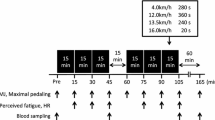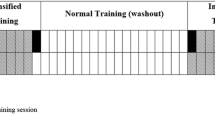Abstract
Purpose
The purpose of this study was to compare the effect of upper and lower body high-intensity intermittent exercise (HIIE) on immunometabolism profile.
Methods
Seven male judo athletes completed two experimental sessions separated by at least 48 h. The athletes completed four bouts of the upper and lower body Wingate tests separated by 3-min recovery periods. The blood samples were collected at rest and immediately after the fourth bout of lower and upper body Wingate tests. Serum was analysed for IL-1ra (Interleukin-1 Receptor Antagonist), interleukins (IL-1) IL-2, IL-4, IL-6, IL-10, TNF-α (tumor necrosis factor alpha), cortisol, glucose, and NEFA (non-ester fatty acid). Peak power (maximum power attained during the 30 s test), mean power were calculated. In addition, after 1 and 2.5-min of each Wingate bout, blood samples from the ear lobe were collected for lactate analysis.
Results
Our data demonstrated that lower body HIIE promoted a greater metabolic rate (values pre- vs. post-Wingate, for lactate: 1.02 ± 0.16 vs. 14.44 ± 1.08 mmol/L; for glucose: 112.5 ± 16.7 vs. 147.9 ± 23.5 mg/dL) and resulted in higher mechanical (mean power: 621 ± 46 vs. 427 ± 40 W, peak power: 794 ± 61 vs. 602 ± 109 W) performance compared to the upper body HIIE (lactate: 0.85 ± 0.18 vs. 12.69 ± 0.74 mmol/L; for glucose: 115.3 ± 20.4 vs. 123.7 ± 28.6 mg/dL; mean power: 480 ± 46 vs. 341 ± 45 W; and peak power: 672 ± 83 vs. 501 ± 120 W), but NEFA showed a similar response to both conditions, with increased IL-10 levels.
Conclusions
In conclusion, our results demonstrated that despite the higher performance in lower body HIIE, the inflammatory response did not differ between exercise modalities.


Similar content being viewed by others
Abbreviations
- HIIE:
-
High-intensity intermittent exercise
- IL-10:
-
Interleukin 10
- IL-13:
-
Interleukin 13
- IL-13Rα1:
-
Interleukin 13 receptor alpha 1
- IL-1ra:
-
Interleukin-1 receptor antagonist
- IL-2:
-
Interleukin 2
- IL-4:
-
Interleukin 4
- IL-4Rα:
-
Interleukin 4 receptor alpha
- IL-6:
-
Interleukin 6
- NEFA:
-
Non-ester fatty acid
- TNF-α:
-
Tumor necrosis factor alpha
References
Antosiewicz J, Kaczor JJ, Kasprowicz K, Laskowski R, Kujach S, Luszczyk M, Radziminski L, Ziemann E (2013) Repeated “all out” interval exercise causes an increase in serum hepcidin concentration in both trained and untrained men. Cell Immunol 283:12–17. doi:10.1016/j.cellimm.2013.06.006 (Epub 2013 Jun 20)
Arent SM, Senso M, Golem DL, McKeever KH (2010) The effects of the aflavin-enriched black tea extract on muscle soreness, oxidative stress, inflammation, and endocrine responses to acute anaerobic interval training: a randomized, double-blind, crossover study. J Int Soc Sports Nutr 7(1):11. doi:10.1186/1550-2783-7-11
Biswas SK, Mantovani A (2012) Orchestration of metabolism by macrophages. Cell Metab 15(4):432–437. doi:10.1016/j.cmet.2011.11.013.Review
Buchheit M, Laursen PB (2013) High-intensity interval training, solutions to the programming puzzle: Part I: cardiopulmonary emphasis. Sports Med 43(5):313–338. doi:10.1007/s40279-013-0029-x.Review
Fischer CP (2006) Interleukin-6 in acute exercise and training: what is the biological relevance? Exerc Immunol Rev 12:6–33 (Review)
Franchini E, Del Vecchio FB, Matsushigue KA, Artioli GG (2011) Physiological profiles of elite judo athletes. Sports Med 41(2):147–166. doi:10.2165/11538580-000000000-00000.Review
Gökbel H, Okudan N, Gül I, Belviranli M, Gergerlioğlu HS, Başaral MK (2012) Effects of repeated bouts of supramaximal exercise on plasma adiponectin, interleukin-6, and tumor necrosis factor-α levels in sedentary men. J Strength Cond Res 26(6):1675–1679. doi:10.1519/JSC.0b013e318231ac1c
Inbar O, Bar-Or O, Skinner JS (1996) The Wingate anaerobic test. Human Kinetics, Champaign
Laskowski R, Ziemann E, Olek RA, Zembron-Lacny A (2011) The effect of three days of judo training sessions on the inflammatory response and oxidative stress markers. J Hum Kinet 30:65–73. doi:10.2478/v10078-011-0074-1 (Epub 2011 Dec 25)
Lee Kong JH, Jang JY, Han JS, Yul J, Lee J, Kim JB (2014) Lipid droplet protein LID-1 mediates ATGL-1-dependent lipolysis during fasting in Caenorhabditis elegans. Mol Cell Biol 34:4165–4176 (pii:MCB.00722-14, Epub ahead of print)
Leggate Nowell MA, Jones SA, Nimmo MA (2010) The response of interleukin-6 and soluble interleukin-6 receptor isoforms following intermittent high intensity and continuous moderate intensity cycling. Cell Stress Chaperones 15:827–833. doi:10.1007/s12192-010-0192-z (Epub 2010 Apr 16)
Libardi CA, De Souza GV, Cavaglieri CR, Madruga VA, Chacon-Mikahil MP (2012) Effect of resistance, endurance, and concurrent training on TNF-α, IL-6, and CRP. Med Sci Sports Exerc 44(1):50–56. doi:10.1249/MSS.0b013e318229d2e9
Lira Rosa FS, Zanchi NE, Yamashita AS, Lopes RD, Lopes AC, Batista ML Jr, Seelaender M (2011) Visceral fat decreased by long-term interdisciplinary lifestyle therapy correlated positively with interleukin-6 and tumor necrosis factor-α and negatively with adiponectin levels in obese adolescents. Metabolism 60:359–365. doi:10.1016/j.metabol.2010.02.017 (Epub 2010 Mar 31)
Lira FS, Rosa JC, Zanchi NE, Yamashita AS, Lopes RD, Lopes AC, Batista ML Jr, Seelaender M (2009) Regulation of inflammation in the adipose tissue in cancer cachexia: effect of exercise. Cell Biochem Funct 27(2):71–75. doi:10.1002/cbf.1540.Review
Lira FS, Neto JC, Seelaender M (2014) Exercise training as treatment in cancer cachexia. Appl Physiol Nutr Metab 39:679–686. doi:10.1139/apnm-2013-0554 (Epub 2014 Mar 24)
Meckel Y, Eliakim A, Seraev M, Zaldivar F, Cooper DM, Sagiv M, Nemet D (2009) The effect of a brief sprint interval exercise on growth factors and inflammatory mediators. J Strength Cond Res 23(1):225–230. doi:10.1519/JSC.0b013e3181876a9a
Meckel Y, Nemet D, Bar-Sela S, Radom-Aizik S, Cooper DM, Sagiv M, Eliakim A (2011) Hormonal and inflammatory responses to different types of sprint interval training. J Strength Cond Res 25(8):2161–2169. doi:10.1519/JSC.0b013e3181dc4571
Neto JC, Lira FS, de Mello MT, Santos RV (2011) Importance of exercise immunology in health promotion. Amino Acids 41:1165–1172. doi:10.1007/s00726-010-0786-x (Epub 2010 Oct 26. Review)
Nieman DC, Henson DA, Smith LL, Utter AC, Vinci DM, Davis JM, DE Kaminsky, Shute M (2001) Cytokine changes after a marathon race. J Appl Physiol (1985) 91:109–114
Ostrowski K, Rohde T, Asp S, Schjerling P, Pedersen BK (1999) Pro- and anti-inflammatory cytokine balance in strenuous exercise in humans. J Physiol 515(Pt 1):287–291
Pedersen BK (2009) The diseasome of physical inactivity and the role of myokines in muscle–fat cross talk. J Physiol 587:5559–5568. doi:10.1113/jphysiol.2009.179515 (Epub 2009 Sep 14. Review)
Pedersen BK (2012) Muscular interleukin-6 and its role as an energy sensor. Med Sci Sports Exerc 44(3):392–396. doi:10.1249/MSS.0b013e31822f94ac.Review
Pedersen BK, Febbraio MA (2008) Muscle as an endocrine organ: focus on muscle-derived interleukin-6. Physiol Rev 88(4):1379–1406
Petersen AM, Pedersen BK (2005) The anti-inflammatory effect of exercise. J Appl Physiol (1985) 98:1154–1162 (Review)
Prokopchuk O, Liu Y, Wang L, Wirth K, Schmidtbleicher D (2007) Steinacker JM: Skeletal muscle IL-4, IL-4Ralpha, IL-13 and IL-13Ralpha1 expression and response to strength training. Exerc Immunol Rev 13:67–75
Rosa JC, Lira FS, Eguchi R, Pimentel GD, Venâncio DP, Cunha CA, Oyama LM, De Mello MT, Seelaender M, do Nascimento CM (2011) Exhaustive exercise increases inflammatory response via Toll like receptor-4 and NF-κBp65 pathway in rat adipose tissue. J Cell Physiol 226:1604–1607. doi:10.1002/jcp.22490
Seelaender M, Batista M Jr, Lira F, Silverio R, Rossi-Fanelli F (2012) Inflammation in cancer cachexia: to resolve or not to resolve (is that the question?). Clin Nutr 31(4):562–566 (Epub 2012 Feb 19)
Starkie RL, Arkinstall MJ, Koukoulas I, Hawley JA, Febbraio MA (2001) Carbohydrate ingestion attenuates the increase in plasma interleukin-6, but not skeletal muscle interleukin-6mRNA, during exercise in humans. J Physiol 533(Pt 2):585–591
Steinacker JM et al (2004) New aspects of the hormone and cytokine response to training. Eur J Appl Physiol 91:382–391 (Epub 2003 Nov 8. Review)
White GE, Rhind SG, Wells GD (2014) The effect of various cold-water immersion protocols on exercise-induced inflammatory response and functional recovery from high-intensity sprint exercise. Eur J Appl Physiol 114:2353–2367 (Epub ahead of print)
Acknowledgments
Fabio Santos Lira thanks Fapesp for their support (2013/25310-2), and Emerson Franchini thanks Fapesp (2012/00220-8).
Conflict of interest
The authors declare that they have no conflict of interest.
Author information
Authors and Affiliations
Corresponding author
Additional information
Communicated by Fabio Fischetti.
Rights and permissions
About this article
Cite this article
Lira, F.S., Panissa, V.L.G., Julio, U.F. et al. Differences in metabolic and inflammatory responses in lower and upper body high-intensity intermittent exercise. Eur J Appl Physiol 115, 1467–1474 (2015). https://doi.org/10.1007/s00421-015-3127-7
Received:
Accepted:
Published:
Issue Date:
DOI: https://doi.org/10.1007/s00421-015-3127-7




